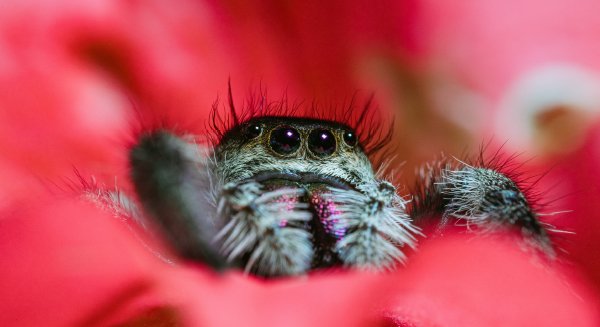Adorable Arachnids
Take one look at a jumping spider and you might think, There’s no way a spider can be that cute! With their big eyes and even bigger personalities, jumping spiders really are adorable.
But God made these creatures to be more than just cute. From impressive stunts to special senses, these spiders’ God-given abilities not only make them fun to watch, but also help them survive.
Pop Goes the Spider!
Jumping spiders jump to catch prey (insects like flies and moths) or to escape from predators (such as birds, lizards, and wasps). Before Adam and Eve disobeyed God and sin entered the world, animals didn’t eat each other. But now, in a world cursed because of sin, spiders and many other animals hunt each other for their next meal.
Humans and most animals jump using muscles in their legs. But jumping spiders are some of the only creatures on earth that use blood pressure to launch themselves off the ground.
Before a jumping spider leaps, the blood in its body rushes to its legs. The pressure in its legs builds, and then . . . POP! All of its legs spread at the same time, launching the jumping spider into the air.
Even though these spiders are often less than half an inch big, they can jump over six inches high. That would be like a four-foot-tall human (an average six-year-old) jumping higher than 48 feet—the height of a four-story building!
Catch Me on the Web
Jumping spiders don’t weave webs to catch their prey. Instead, they use their webs to create little sleeping bags for themselves on the bark of trees, undersides of leaves, or any other safe place they can find.
Jumping spiders also use their webs like bungee cords. They always have a strand of silk connected to what they’re standing on, just in case they need to spring away. This silk “rope” keeps their flying leaps on course and catches them if they jump a little too far.
What Big Eyes You Have!
Like most spiders, jumping spiders have four pairs of eyes. But unlike typical web-spinning spiders, jumping spiders’ eyes are especially suited for hunting. Because these spiders chase fast-moving prey, God gave them large, forward-facing eyes with the best vision of any spider. Besides these powerful primary eyes, jumping spiders have six smaller eyes, two facing forward and four on the sides of their head. These perfectly placed eyes help jumping spiders catch prey and see predators coming from nearly every angle. Jumping spiders see the world in black and white with their six small eyes, but they can see in color with their large forward-facing eyes.
Spidey Senses
Fantastic vision isn’t the only spectacular sense jumping spiders rely on to track down prey. These spiders are also very sensitive to vibrations. Though they don’t have ears, they can “hear” through hairs on their legs. Sound vibrations travel through the ground to the spiders’ legs, telling them when prey or predators are approaching.
Besides hearing through their legs, it’s possible that jumping spiders can even “taste” what they’re walking on. We still have a lot to learn about the way jumping spiders experience the world around them, but we know this for sure: their special spider senses make them some of the best hunters around.

Flight over Fight
Jumping spiders almost never bite humans. They only eat smaller creatures, so they won’t bother attacking something larger unless they feel threatened. And even then, jumping spiders are super shy, so they would much rather hop away from danger than sink their teeth into it. Most jumping spiders are so small that if they did bite, it would be no worse than a mosquito bite. As long as you are gentle with these creatures and give them some space, they would much rather be your friend than your enemy. These surprisingly friendly spiders remind us that we shouldn’t jump to conclusions about God’s creatures.
Fun Facts
- With over 6,380 different species, jumping spiders are the largest spider family.
- Jumping spiders can range from nearly one inch big to smaller than a sesame seed!
- Jumping spiders live on every continent except Antarctica.

Nefertiti the “Spidernaut”
Spider in Space!
In 2011, a jumping spider named Nefertiti (pictured on the right) became the first “Spidernaut.” She was sent to space as part of an experiment to see if jumping spiders could adapt to low gravity. Nefertiti spent 100 days in orbit at the International Space Station, where she quickly adapted and proved that she could hunt in space as well as on earth. When Nefertiti returned home from her adventure, she went to live at the Insect Zoo at the Smithsonian Institution’s National Museum of Natural History in Washington.
Kids Answers Magazine
Before Your Birthday
Months before your birthday, God was knitting you together in your mother’s womb (Psalm 139:13).
Browse Kids Issue- © 2025 Answers in Genesis
- Privacy Policy
- Contact
- About

